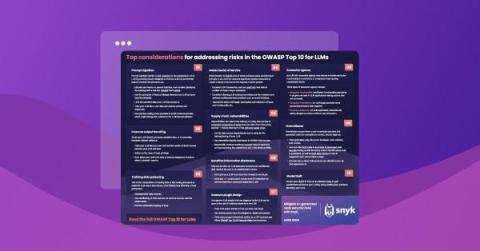Security | Threat Detection | Cyberattacks | DevSecOps | Compliance
AI
Breaking the Barrier of Dynamic Testing: Detect and Autoconfigure Entry Points With CI Spark
The new master mind of cybercrimes: Artificial intelligence
Imagine an AI overlord sitting in a dark basement, plotting world domination through cybercrime. While the idea might seem like a sci-fi flick, it’s actually closer to reality than we think. AI has emerged as a game changer in a constantly evolving cyber landscape. AI algorithms can learn and adapt to security measures quickly, making them the ultimate cyber villains.
Deep learning in security: text-based phishing email detection with BERT model
Top considerations for addressing risks in the OWASP Top 10 for LLMs
Welcome to our cheat sheet covering the OWASP Top 10 for LLMs. If you haven’t heard of the OWASP Top 10 before, it’s probably most well known for its web application security edition. The OWASP Top 10 is a widely recognized and influential document published by OWASP focused on improving the security of software and web applications. OWASP has created other top 10 lists (Snyk has some too, as well as a hands-on learning path), most notably for web applications.
How to safeguard your AI ecosystem: The imperative of AI/ML security assessments
8 questions about AI and compliance
AI is one of the hottest topics in tech right now. More than half of consumers have already tried generative AI tools like ChatGPT or DALL-E. According to a Gartner poll, 70% of executives say their business is investigating and exploring how they can use generative AI, while 19% are in pilot or production mode. Business use cases for AI range from enhancing the customer experience (38%), revenue growth (26%), and cost optimization (17%).
Keeping cybersecurity regulations top of mind for generative AI use
Can businesses stay compliant with security regulations while using generative AI? It’s an important question to consider as more businesses begin implementing this technology. What security risks are associated with generative AI? It's important to earn how businesses can navigate these risks to comply with cybersecurity regulations.
The Stealthy Threat of AI Prompt Injection Attacks
Just last week the UK’s NCSC issued a warning, stating that it sees alarming potential for so-called prompt injection attacks, driven by the large language models that power AI. The NSCS stated “Amongst the understandable excitement around LLMs, the global tech community still doesn‘t yet fully understand LLM’s capabilities, weaknesses, and (crucially) vulnerabilities.











